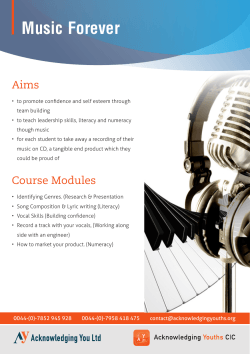
MCQ on Services Marketing Unit 1
MCQ: Unit-I: Introduction to Services marketing 1. A ______________________ is a form of product that consists of activities, benefits, or satisfactions offered for sale that are essentially intangible and do not result in the ownership of anything. a. b. c. d. Service Demand Need Physical object 2. Distinct characteristic of services is_____________ a. b. c. d. Intangibility Inseparability Variability Perishability 3. All of the following are examples of services EXCEPT: e. f. g. h. a. b. c. d. banking. hotels and motels. tax preparation. computer software. 4. Services are typically produced and consumed simultaneously. This is an example of the ________characteristic of services. a. b. c. d. e. Intangibility Variability Inseparability Simultaneously Perishability 5. Services can not be stored. This describes the ___________characteristic of services. a. b. c. d. e. Intangibility Variability Inseparability Inconsistency Perishability 6. Examples of pure tangible goods include all of the following EXCEPT: a. Soap. b. Tax preparation. c. Toothpaste. d. Salt. 7. __________describes the employees skills in serving the client. a. b. c. d. e. Internal Marketing External Marketing Relationship marketing Interactive marketing Communication Marketing 8. SSTS refers to __________ a. b. c. d. Service Standards Testing Self- Service Technologies Standard Service Technologies Self Service Treatments 9. _____________ occurs when a company intentionally uses services as the stage, and goods as the props, to engage individual customers in a way that creates a memorable event. a. b. c. d. Hybrid offer Core service Augmented or ancillary product Experience 10. Top firms audit service performance by collecting_________measurements to probe customer satisfiers and dissatisfiers. a. b. c. d. Customer satisfier Customer complaint Voice of the customer Psychological 11. The services a customer expects are called the ______service package. a. b. c. d. e. Expected Augmented Primary Secondary Perceived 12. The fact that a business traveler may have one very positive check-in experience at a hotel and then a very negative check-in experience with a different employee on a subsequent visit is evidence of service: a. b. c. d. intangibility. inseparability. variability. perishability. 13. Added features to an offering are called _________service features. a. b. c. d. e. Expected Augmented Primary Secondary Perceived 14. The intangibility of services has implications for the choice of _________ a. b. c. d. e. Brand elements Location Price Product features Channels of distribution 15. __________cost refers to the product’s purchase cost plus the discounted cost of maintenance and repair less the discounted salvage value a. b. c. d. e. Total Variable Life cycle Net Out of pocket 16. Successful service companies focus their attention on both their customers and their employees. They understand ___________________, which links service firm profits with employee and customer satisfaction. a. b. c. d. Internal marketing Service-profit chains Interactive marketing Service differentiation 17. If a firm is practicing ____________________, the firm is training and effectively motivating its customer-contact employees and all of the supporting service people to work as a team to provide customer satisfaction. a. b. c. d. Double-up marketing Internal marketing Interactive marketing Service marketing 18. According to Parasuraman, Zeithaml & Berry , the most important determinant of service quality is : a. b. c. d. e. Responsiveness Reliability Assurance Empathy Tangibles 19. The extended marketing mix for services includes: People, Processes and _________ a. b. c. d. Product Place Physical Evidence Promotion 20. Which of the following is not an element of physical evidence? a. b. c. d. Employee Dress Employee Training Equipment Facility Design 21. Which of the following is not an element of people? a. b. c. d. Motivation Teamwork Flow of activities Customer training 22. Standardized and customized flow of activities , simple and complex number of steps and customer involvement by which a service is delivered is called – a. b. c. d. Place Mix Physical evidence mix Process mix People mix 23. _ _________ is the environment in which the service is delivered and where the firm and customer interact and any tangible components that facilitates performance or communication of the service. a. b. c. d. Physical evidence Process Place People 24. All human actors who play a part in service delivery and thus influence the buyers perceptions : namely , the firms personnel,, the customer and other customers in the service environment. a. b. c. d. Process Physical environment People Place 25. ____________ is a tool for simultaneously depicting the service process , the points of customer contact and the evidence of service from the customers point of view . a. b. c. d. Front of Planning Service Blueprinting Service standardization None of these 26. __________ is the physical surroundings or the physical facility where the service is produced, delivered and consumed. a. b. c. d. Servicespace Servicescape Serviceplace Servicescope 27. ___________ are the only service distributors which do not require direct human interactions. a. b. c. d. Electronic channels SST’s Direct Service channels Speculative channels 28. In the absence of a physical product, service providers need to consider the use of ______________ that enable customers to make a judgment on the service quality. a. b. c. d. Intangible clues Tangible clues Blueprint Performance measures 29. Compared with low-contact services, customers of high-contact services are more likely to judge service quality on the basis of: a. b. c. d. Price of the service Processes used in carrying out the service Intangible outcomes eg. The performance of an investment portfolio Tangible outcomes 30. Which of the following is not generally accepted as being part of the extended marketing mix for services? a. b. c. d. Product Price Process Practice
© Copyright 2025












